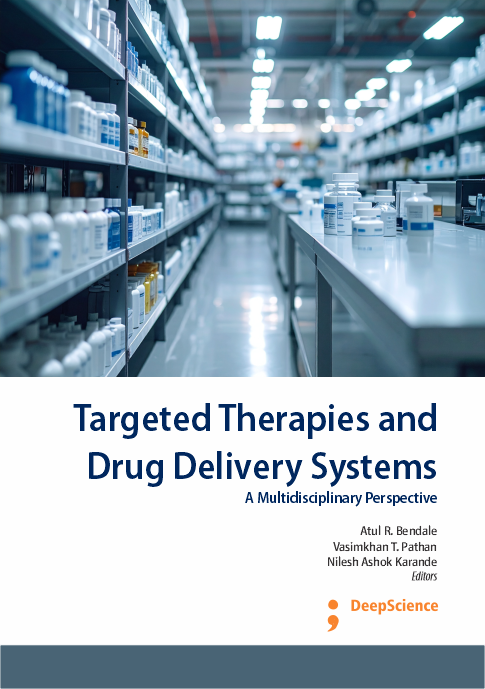Targeted Therapies and Drug Delivery Systems: A Multidisciplinary Perspective
Keywords:
Targeted Drug Delivery, Nanotechnology , Liposomal Drug Delivery , Stimuli-Responsive Polymers , Smart Polymers , Theranostics , Polymeric NanoparticlesSynopsis
We are pleased to present the edited volume titled "Targeted Therapies and Drug Delivery Systems: A Multidisciplinary Perspective." This book brings together recent advancements in drug delivery, formulation science, and therapeutic innovations from across multiple disciplines.
The chapters explore a wide range of topics, including liposomal formulations, stimuli-responsive polymers, ligand-based targeting, and the growing role of nanotechnology in improving drug delivery and efficacy. The integration of natural products with modern medicine and the importance of clinical pharmacy and pharmacovigilance are also highlighted, reflecting a balanced approach between traditional wisdom and cutting-edge science.
This volume aims to serve as a valuable resource for students, researchers, and professionals in the pharmaceutical and biomedical fields. We thank all contributors for their expertise and hope this book inspires further innovation in patient-centered drug delivery systems.
Chapters
-
Advances in liposomal drug delivery: Formulation and optimization
-
Stimuli responsive polymers used in drug delivery systems
-
Advancements in nanotechnology for drug delivery
-
Natural products and traditional medicines: integration with modern therapeutics
-
Clinical pharmacy and pharmacovigilance: Integrating patient-centred care with drug safety monitoring
-
Nanotechnology applications in drug delivery and therapeutics
-
Innovations in pharmaceutical formulation and delivery system
-
Targeted drug delivery strategies: Ligand-based approaches
References
Has, C. and Sunthar, P. (2020) ‘A comprehensive review on recent preparation techniques of liposomes’, Journal of Liposome Research, 30(4), pp. 336–365.
Sakshi, ranjan kumar singh, “liposomes - an updated overview”, international journal of pharma professional’s research, Volume – 15, Issue – 1, January – 2024, 119-127.
Theresa M. Allen, Pieter R. Cullis, Liposomal drug delivery systems: From concept to clinical application, Advanced Drug Delivery Reviews, 65 (2013) 36–48.
Hamdi Nsairat, Walhan Alshaer, Fadwa Odeh, Ezzaldeen Esawi, Recent advances in using liposomes for delivery of nucleic acid-based therapeutics, Open Nano 11 (2023),4-5.
Shivani Sarafa, Ankit Jainab, Ankita Tiwaria, Amit Vermaa, Pritish Kumar Pandaa, Sanjay K. Jaina, Journal of Drug Delivery Science and Technology, 56 (2020), page no:2
Shantanu Pande, Liposomes for drug delivery: review of vesicular composition, factors affecting drug release and drug loading in liposomes, Artificial Cells, Nanomedicine, and Biotechnology an International Journal, 2023, VOL. 51, NO. 1, 428–440.
Claudia Zylberberg and Sandro Matosevic, Pharmaceutical liposomal drug delivery: a review of new delivery systems and a look at the regulatory landscape, Drug Delivery, 2016; 23(9): 3319–3329.
Patrick J. Sinko, Martin’s Physical Pharmacy and Pharmaceutical Sciences, 7th Edition, Wolters Kluwer,
Dr. Shailesh Thanaji Prajapati , Dr. R. Manivannan, Novel Drug Delivery System: e-Book, Thakur Publication Private Limited, 171.
Rani M. Mhetre, Rupali V. Waghmode, Sandhya S. Khyamgonde, Rohit S. Nilee, Vijaysinh U. Sable and Rahul I. Jadhav, Liposome: An advanced pharmaceutical carrier in novel drug delivery system, International Journal of Science and Research Archive, 2023, 10(02), 874–894.
Twinkle Gupta1, Priyanshu Nema1, Sakshi Soni1, Vivek Yadav2, Sanyog Jain2, Vandana Soni1 and Sushil K. Kashaw1 Preparation and in vitro evaluation of BBG‑250 loaded liposomal formulation for anticancer potential, Future Journal of Pharmaceutical Sciences, (2024), 1-16.
1Dipti U. Padole, 2Shrikant D. Pande, 3Roshani A. Sawarkar, 4Tusharkumar G. Ingle, 5Nikita S. Jain, Review on: recent advances in liposomal drug delivery system, International Journal of Creative Research Thoughts (IJCRT), Volume 11, Issue 4 April 2023, 928.
Stefano Giordani , Valentina Marassi, Andrea Zattoni, Barbara Roda, Pierluigi Reschiglian, Liposomes characterization for market approval as pharmaceutical products: Analytical methods, guidelines and standardized protocols, Journal of Pharmaceutical and Biomedical Analysis 236 (2023)-3.
Muhammad Taher, Deny Susanti, Muhammad Salahuddin Haris, Riyanto Teguh Widodo, Yandi Syukri, Junaidi Khoti, PEGylated liposomes enhance the effect of cytotoxic drug: A review, Heliyon 9,(2023) ,13823.
Torchilin VP. Recent advances with liposomes as pharmaceutical carriers. Nat Rev Drug Discov. 2005 Feb;4(2):145-60. doi: 10.1038/nrd1632..
Liu P, Chen G, Zhang J. A Review of Liposomes as a Drug Delivery System: Current Status of Approved Products, Regulatory Environments, and Future Perspectives. Molecules. 2022 Feb 17;27(4):1372. doi: 10.3390/molecules27041372.
Nikolova MP, Kumar EM, Chavali MS. Updates on Responsive Drug Delivery Based on Liposome Vehicles for Cancer Treatment. Pharmaceutics. 2022 Oct 15;14(10):2195. doi: 10.3390/pharmaceutics14102195.
Li, Y., Maciel, D., Rodrigues, J., Shi, X., & Tomás, H. (2015). Biodegradable polymer nanogels for drug/nucleic acid delivery. Chemical Reviews, 115(16), 8564–8608. https://doi.org/10.1021/cr500614t
Kim, D., et al. (2011). Disulfide-bonded polymer micelles for glutathione-mediated intracellular drug delivery. Biomaterials, 32(9), 2359–2367. https://doi.org/10.1016/j.biomaterials.2010.11.070
Lee, H., Mok, H., Lee, S., Oh, Y.-K., & Park, T. G. (2007). Target-specific intracellular delivery of siRNA using degradable hyaluronic acid nanogels. Journal of Controlled Release, 119(2), 245–252. https://doi.org/10.1016/j.jconrel.2007.02.013
Makadia, H. K., & Siegel, S. J. (2011). Poly lactic-co-glycolic acid (PLGA) as biodegradable controlled drug delivery carrier. Polymers, 3(3), 1377–1397. https://doi.org/10.3390/polym3031377
Zhao, Y., & Ikeda, T. (2009). Smart light-responsive materials: Azobenzene-containing polymers and liquid crystals. Wiley, Journal of Materials Chemistry, 19(29), 4915–4936. https://doi.org/10.1039/B818376A
Peppas, N. A., Bures, P., Leobandung, W., & Ichikawa, H. (2000). Hydrogels in pharmaceutical formulations. European Journal of Pharmaceutics and Biopharmaceutics, 50(1), 27–46. https://doi.org/10.1016/S0939-6411(00)00090-4
Lee, C. C., MacKay, J. A., Frechet, J. M. J., & Szoka, F. C. (2005). Designing dendrimers for biological applications. Nature Biotechnology, 23(12), 1517–1526. https://doi.org/10.1038/nbt1171
Gil, E. S., & Hudson, S. M. (2004). Stimuli-responsive polymers and their bioconjugates. Progress in Polymer Science, 29(12), 1173–1222. https://doi.org/10.1016/j.progpolymsci.2004.08.002
Makadia, H. K., & Siegel, S. J. (2011). PLGA as biodegradable controlled drug delivery carrier. Polymers, 3(3), 1377–1397. https://doi.org/10.3390/polym3031377
Qiu, Y., & Park, K. (2001). Environment-sensitive hydrogels for drug delivery. Advanced Drug Delivery Reviews, 53(3), 321–339. https://doi.org/10.1016/S0169-409X(01)00203-4
Bae, Y., Fukushima, S., Harada, A., & Kataoka, K. (2003). Design of environment-sensitive supramolecular assemblies for intracellular drug delivery: polymeric micelles that are responsive to intracellular pH change. Angewandte Chemie International Edition, 42(38), 4640–4643. https://doi.org/10.1002/anie.200351451
Sahoo, S. K., Mallick, A. A., & Barik, B. B. (2009). pH-sensitive hydrogels for colon-targeted drug delivery. International Journal of Pharmacy and Pharmaceutical Sciences, 1(1), 33–40.
Bae, Y., Fukushima, S., Harada, A., & Kataoka, K. (2003). Design of environment-sensitive supramolecular assemblies for intracellular drug delivery. Angewandte Chemie International Edition, 42(38), 4640–4643. https://doi.org/10.1002/anie.200351451
Kukowska-Latallo, J. F., Candido, K. A., Cao, Z., Nigavekar, S. S., Majoros, I. J., Thomas, T. P., Balogh, L. P., Khan, M. K., & Baker, J. R. (2005). Nanoparticle targeting of anticancer drug improves therapeutic response in animal model of human epithelial cancer. Cancer Research, 65(12), 5317–5324. https://doi.org/10.1158/0008-5472.CAN-04-3921
Vinogradov, S. V., Bronich, T. K., & Kabanov, A. V. (2004). Nanosized cationic hydrogels for drug delivery: preparation, properties and interactions with cells. Advanced Drug Delivery Reviews, 56(9), 1351–1375. https://doi.org/10.1016/j.addr.2003.12.003
Ahmed, F., Pakunlu, R. I., Srinivas, G., Brannan, A., Bates, F., Klein, M. L., & Minko, T. (2006). Shrinkage of a rapidly growing tumor by drug-loaded polymersomes: pH-triggered release through copolymer degradation. Molecular Pharmaceutics, 3(3), 340–350. https://doi.org/10.1021/mp0501020
Bae, Y., Fukushima, S., Harada, A., & Kataoka, K. (2005). Design of environment-sensitive supramolecular assemblies for intracellular drug delivery. Angewandte Chemie International Edition, 44(38), 532–535. https://doi.org/10.1002/anie.200462205
Sinha, V. R., & Kumria, R. (2001). Polysaccharides in colon-specific drug delivery. International Journal of Pharmaceutics, 224(1–2), 19–38. https://doi.org/10.1016/S0378-5173(01)00720-7
Saraiva, C., Praca, C., Ferreira, R., Santos, T., Ferreira, L., & Bernardino, L. (2016). Nanoparticle-mediated brain drug delivery: Overcoming blood–brain barrier to treat neurodegenerative diseases. Journal of Controlled Release, 235, 34–47. https://doi.org/10.1016/j.jconrel.2016.05.044
Jani, P., Gohel, M., & Amin, A. (2007). Formulation and optimization of novel pH-sensitive polymeric nanoparticles for oral delivery of insulin. AAPS PharmSciTech, 8(2), E1–E8. https://doi.org/10.1208/pt0802043.
Oupický, D., Li, J., Konák, C., & Seymour, L. W. (2002). Self-assembling and pH-sensitive polyplexes for gene delivery. Journal of Controlled Release, 81(1–2), 113–123. https://doi.org/10.1016/S0168-3659(02)00042-3
Godbey, W. T., Wu, K. K., & Mikos, A. G. (1999). Tracking the intracellular path of poly(ethylenimine)/DNA complexes for gene delivery. Proceedings of the National Academy of Sciences, 96(9), 5177–5181. https://doi.org/10.1073/pnas.96.9.5177
Gil, E. S., & Hudson, S. M. (2004). Stimuli-responsive polymers and their bioconjugates. Progress in Polymer Science, 29(12), 1173–1222. https://doi.org/10.1016/j.progpolymsci.2004.08.002
Kabanov, A. V., & Batrakova, E. V. (2004). Polymeric micelles as nanocarriers for drug and gene delivery. Nanomedicine: Nanotechnology, Biology and Medicine, 2(3), 168–182. https://doi.org/10.1016/j.nano.2006.06.001
Roy, D., Cambre, J. N., & Sumerlin, B. S. (2010). Future perspective and recent advances in stimuli-responsive polymeric materials. Progress in Polymer Science, 35(1–2), 278 301.
Zhang, X.-Z., & Chen, Y. (2013). Stimuli-responsive water-soluble polymers and their application as intelligent material systems. Materials Science and Engineering: R: Reports, 81, 1–28.
Schmaljohann, D. (2006). Thermo- and pH-responsive polymers in drug delivery. Advanced Drug Delivery Reviews, 58(15), 1655–1670.
Bae, Y., Okano, T., Hsu, R., et al. (1998). Thermo responsive polymeric micelles composed of poly(N-isopropylacrylamide)-block poly(DL-lactide) for drug delivery. Journal of Controlled Release, 58(2), 189–199.
Qiu, Y., & Park, K. (2001). Environment-sensitive hydrogels for drug delivery. Advanced Drug Delivery Reviews, 53(3), 321–339.
Barrett, D. G., Saito, E., Inomata, H., & Honda, S. (2021). Stimuli-responsive polymeric nanoparticles for precision drug delivery. Nature Reviews Materials, 6, 710–726.
Hu, X., et al. (2016). Enzyme-responsive polymeric carriers for bioactive cargo delivery. Advanced Materials, 28(44), 9703–9718.
Hennink, W. E., & van Nostrum, C. F. (2012). Novel crosslinking methods to design hydrogels. Advanced Drug Delivery Reviews, 64, 223–236.
Kievit, F. M., & Zhang, M. (2011). Theranostic nanoparticles for drug delivery and imaging. MRS Bulletin, 36(9), 684–691.
Li, Y., et al. (2017). Dual pH and temperature sensitive block copolymers for cancer therapy. Biomacromolecules, 18(3), 1012–1023.













